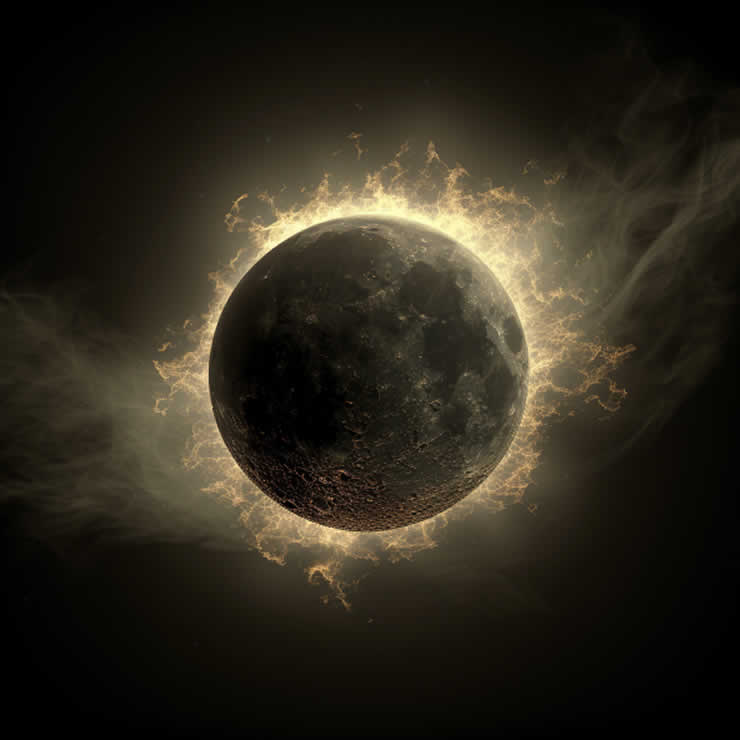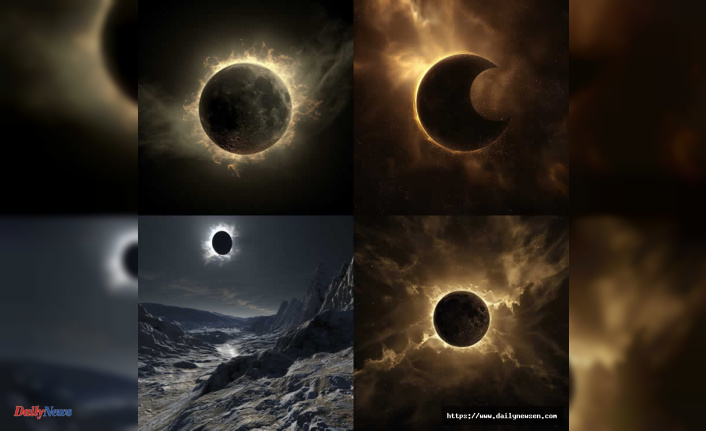The Fascinating World of Solar Eclipses
Solar eclipses are one of the most captivating celestial events that occur in our solar system. These phenomena occur when the moon passes between the Earth and the sun, casting a shadow on the Earth's surface. What makes solar eclipses particularly intriguing is their rarity and the stunning visual display they create in the sky.
The anticipation leading up to a solar eclipse is palpable, with astronomers and enthusiasts alike eagerly awaiting the chance to witness this extraordinary event. From the moment the moon begins to obscure the sun's disk to the eerie darkness that falls during totality, solar eclipses offer a spectacle unlike any other.
As the moon gradually moves across the sun, observers are treated to a variety of stunning phenomena, including the diamond ring effect, where a bright burst of sunlight appears just before totality, and shadow bands, thin wavy lines of light that dance across the ground in the moments leading up to and following totality.
Understanding the Mechanics of a Solar Eclipse

The mechanics of a solar eclipse are relatively simple, yet the effects they produce are awe-inspiring. Solar eclipses occur when the moon, in its orbit around the Earth, passes directly between the Earth and the sun, casting a shadow on the Earth's surface. This alignment can only occur during a new moon when the moon is positioned between the Earth and the sun.
During a solar eclipse, the moon's shadow falls onto the Earth in two distinct regions: the umbra and the penumbra. The umbra is the central, darkest part of the shadow, where the sun is completely blocked out, creating a total solar eclipse for observers within this area. The penumbra, surrounding the umbra, is a lighter shadow where only a portion of the sun is obscured, resulting in a partial solar eclipse for observers within this region.
The duration of a solar eclipse varies depending on several factors, including the relative sizes and distances of the sun, moon, and Earth. Total solar eclipses, where the sun is completely obscured by the moon, typically last for only a few minutes, while partial solar eclipses can last for several hours as the moon moves across the sun's disk.
Overall, the mechanics of a solar eclipse are a testament to the intricate dance of celestial bodies in our solar system, resulting in a breathtaking display of nature's beauty and wonder.
Exploring the Different Types of Solar Eclipses
Solar eclipses come in several different varieties, each offering a unique viewing experience for observers on Earth. The three main types of solar eclipses are total, partial, and annular eclipses, distinguished by the alignment of the sun, moon, and Earth during the event.
Total Solar Eclipse: A total solar eclipse occurs when the moon completely blocks out the sun, casting a shadow on the Earth's surface. During totality, the sky darkens dramatically, and observers within the path of totality can witness the sun's corona, the outer atmosphere of the sun, glowing brightly around the moon's silhouette. Total solar eclipses are rare events that captivate audiences with their stunning visual display and eerie atmosphere.
Partial Solar Eclipse: In a partial solar eclipse, only a portion of the sun is obscured by the moon, resulting in a partial shadow being cast on the Earth's surface. Observers within the path of the partial eclipse will notice a gradual darkening of the sky as the moon moves across the sun's disk. While not as dramatic as a total eclipse, partial solar eclipses still offer a fascinating opportunity to witness the moon's movement in front of the sun.
Annular Solar Eclipse: An annular solar eclipse occurs when the moon passes directly in front of the sun but does not completely cover it. Instead, a ring of sunlight, known as the "ring of fire," remains visible around the edges of the moon's silhouette. Annular eclipses happen when the moon is at a slightly greater distance from the Earth, causing it to appear smaller in the sky compared to the sun. Observers within the path of an annular eclipse can witness this unique phenomenon, where the sun appears as a bright ring encircling the moon.
Each type of solar eclipse offers a different perspective on this celestial event, providing observers with a variety of awe-inspiring sights and experiences. Whether witnessing the breathtaking beauty of a total eclipse or marveling at the "ring of fire" during an annular eclipse, solar eclipses continue to captivate and inspire audiences around the world.
The Path of Totality: Experiencing a Total Solar Eclipse
One of the most sought-after experiences for solar eclipse enthusiasts is witnessing totality, the moment when the moon completely blocks out the sun, plunging observers into darkness for a brief period of time. This phenomenon occurs along a narrow path known as the path of totality, which varies with each eclipse and is determined by the alignment of the sun, moon, and Earth.
For observers lucky enough to be within the path of totality, the experience of witnessing a total solar eclipse is truly unforgettable. As the moon slowly moves across the sun's disk, the sky darkens, and the temperature drops, creating a surreal atmosphere unlike any other. Birds may stop chirping, and animals may behave strangely as they react to the sudden change in light.
As totality approaches, observers can witness the sun's corona, the outer atmosphere of the sun, glowing brightly around the dark silhouette of the moon. The corona appears as delicate wisps of light streaming out from the edges of the moon, creating a breathtaking display of celestial beauty.
During the brief moments of totality, observers have the opportunity to see stars and planets visible in the darkened sky, adding to the magical experience. Many people describe the sensation of being in the path of totality as profound and transformative, leaving a lasting impression that lasts a lifetime.
Witnessing a total solar eclipse along the path of totality is a bucket-list experience for many, drawing eclipse chasers from around the world to locations where the event will be visible. Whether you're an experienced astronomer or a casual skywatcher, the awe-inspiring spectacle of totality is sure to leave you spellbound.
Safely Viewing a Solar Eclipse: Tips and Precautions
While witnessing a solar eclipse can be a thrilling experience, it's crucial to take precautions to protect your eyes and ensure your safety during the event. Looking directly at the sun, even during an eclipse, can cause permanent damage to your eyesight, so it's essential to use proper viewing techniques and equipment.
One of the safest ways to view a solar eclipse is by using solar eclipse glasses or viewers specifically designed for this purpose. These glasses are equipped with special solar filters that block out harmful ultraviolet and infrared radiation, allowing you to safely observe the sun without risking eye damage. Be sure to check that your eclipse glasses are certified by reputable sources and are not scratched or damaged before use.
Alternatively, you can use solar viewers, such as solar telescopes or solar projection devices, to indirectly observe the eclipse. These devices project an image of the sun onto a screen or surface, allowing you to view the eclipse without looking directly at the sun. Remember to follow the manufacturer's instructions carefully when using these devices to ensure safe viewing practices.
It's also important to avoid improvised viewing methods, such as sunglasses, CDs, or smoked glass, as these materials do not provide adequate protection from the sun's harmful rays. Additionally, never use binoculars or telescopes to view the sun without proper solar filters, as this can magnify the sun's intensity and cause serious eye injury.
By following these safety tips and precautions, you can enjoy the spectacle of a solar eclipse without putting your eyes or health at risk. Remember to plan ahead and prepare your viewing equipment in advance to ensure a safe and enjoyable experience for all.
Solar Eclipse Glasses: Your Essential Gear for Viewing
When it comes to viewing a solar eclipse safely, one of the most essential pieces of equipment you'll need is a pair of solar eclipse glasses. These specialized glasses are designed to protect your eyes from the harmful rays of the sun, allowing you to observe the eclipse without risking damage to your vision.
Solar eclipse glasses are equipped with special solar filters that block out ultraviolet and infrared radiation, as well as intense visible light, ensuring that your eyes are protected during the event. These filters are essential for preventing solar retinopathy, a condition that occurs when the retina is damaged by exposure to the sun's rays.
When selecting solar eclipse glasses, it's important to choose ones that meet international safety standards and are certified by reputable sources. Look for glasses that are labeled as "ISO 12312-2 compliant," indicating that they meet the necessary safety requirements for viewing the sun.
Before using your solar eclipse glasses, be sure to inspect them for any signs of damage, such as scratches or tears in the lenses. Damaged glasses should not be used, as they may not provide adequate protection for your eyes.
During the eclipse, be sure to wear your solar eclipse glasses whenever you are looking directly at the sun, even if it is partially obscured by the moon. Remember that it is never safe to look at the sun without proper eye protection, as doing so can cause permanent damage to your vision.
By investing in a pair of high-quality solar eclipse glasses and following proper safety protocols, you can enjoy the spectacle of a solar eclipse while protecting your eyes and ensuring a memorable viewing experience for years to come.
The Historical Significance of Solar Eclipses
Throughout history, solar eclipses have held a profound significance for cultures around the world. Ancient civilizations often viewed eclipses as omens or portents, interpreting them as signs of impending doom or important events. As a result, solar eclipses were often met with fear and superstition, with people engaging in rituals or making offerings to appease the gods.
One of the earliest recorded accounts of a solar eclipse dates back to ancient China, where eclipses were meticulously observed and recorded by astronomers. In some cases, eclipses were even predicted with remarkable accuracy, demonstrating the advanced astronomical knowledge of ancient Chinese astronomers.
In other cultures, solar eclipses were seen as opportunities for spiritual reflection and renewal. In ancient Egypt, for example, eclipses were associated with the god Amun-Ra, who was believed to temporarily lose his power during an eclipse. To restore his strength, priests would perform rituals and prayers to ensure the sun's return.
In more recent history, solar eclipses have played a crucial role in advancing our understanding of the universe. During the 19th century, scientists used solar eclipses to study the sun's corona, the outer atmosphere of the sun, which is normally too faint to be observed against the brightness of the sun's surface. By observing eclipses from different locations around the world, scientists were able to make groundbreaking discoveries about the sun's structure and behavior.
Today, solar eclipses continue to captivate and inspire people of all ages, serving as reminders of the beauty and wonder of the natural world. Whether viewed through the lens of science, culture, or spirituality, solar eclipses hold a special place in the collective imagination of humanity, connecting us to our past and inspiring us to explore the mysteries of the cosmos.
Cultural Beliefs and Mythologies Surrounding Solar Eclipses
Solar eclipses have long been the subject of mythologies and beliefs in cultures around the world. From ancient civilizations to modern societies, these celestial events have inspired awe, wonder, and sometimes fear among observers.
In many ancient cultures, solar eclipses were seen as powerful omens or portents of significant events. For example, in ancient Mesopotamia, eclipses were interpreted as signs of divine anger or impending disaster, leading people to perform rituals and make offerings to appease the gods.
In Norse mythology, solar eclipses were believed to occur when the sun was swallowed by the wolf Skoll during his pursuit of the sun god Sol. To frighten Skoll away and prevent him from devouring the sun, Norse warriors would shout and bang their weapons, creating a cacophony of noise to scare off the mythical beast.
In Hindu mythology, solar eclipses were attributed to the demon Rahu, who was said to swallow the sun as punishment for his misdeeds. To protect the sun from Rahu's grasp, Hindus would immerse themselves in prayer and meditation during eclipses, seeking divine protection from the forces of darkness.
Even today, solar eclipses continue to be surrounded by superstitions and cultural beliefs in some parts of the world. In some cultures, it is believed that eclipses are a time of heightened spiritual energy, making it an auspicious time for meditation, reflection, and introspection.
While modern science has provided us with a deeper understanding of the mechanics behind solar eclipses, these celestial events continue to inspire wonder and curiosity, reminding us of the enduring power of myth and folklore in shaping our perceptions of the world around us.
How Scientists Study Solar Eclipses: Methods and Instruments
Solar eclipses provide scientists with a unique opportunity to study the sun's outer atmosphere, known as the corona, and gather valuable data about its structure and behavior. To make the most of these rare events, researchers employ a variety of methods and instruments to observe and study solar eclipses.
One of the most common methods used by scientists to study solar eclipses is through ground-based observations. By setting up telescopes equipped with specialized filters and cameras, astronomers can capture high-resolution images and videos of the sun's corona during totality. These observations provide valuable insights into the dynamics of the corona and help scientists better understand phenomena such as solar flares and coronal mass ejections.
In addition to ground-based observations, scientists also utilize spacecraft and satellites to study solar eclipses from space. Space-based observatories, such as NASA's Solar Dynamics Observatory (SDO) and the European Space Agency's Solar Orbiter, provide unprecedented views of the sun's corona from above the Earth's atmosphere. These observations complement ground-based studies and allow scientists to observe the sun in different wavelengths of light, revealing new details about its structure and activity.
Another important aspect of studying solar eclipses is conducting experiments to measure changes in the Earth's atmosphere and environment during the event. Researchers use instruments such as spectrometers, magnetometers, and radiometers to monitor changes in temperature, atmospheric pressure, and electromagnetic activity during eclipses. These experiments help scientists better understand the impact of solar eclipses on the Earth's atmosphere and ionosphere.
Overall, the study of solar eclipses plays a crucial role in advancing our understanding of the sun and its effects on the Earth. By combining ground-based observations, space-based studies, and atmospheric measurements, scientists can gain valuable insights into the complex processes that govern our solar system and universe.
The Impact of Solar Eclipses on Earth and Beyond
Solar eclipses have a profound impact on the Earth and its environment, influencing everything from weather patterns to animal behavior. While the effects of eclipses are relatively short-lived, they can have significant implications for the planet and its inhabitants.
One of the most noticeable effects of a solar eclipse is the temporary drop in temperature that occurs during totality. As the moon blocks out the sun's rays, the Earth's surface cools rapidly, leading to a decrease in temperature of several degrees Fahrenheit in some areas. This sudden change in temperature can affect weather patterns, causing shifts in wind direction and atmospheric pressure.
Solar eclipses also have an impact on animal behavior, with some species exhibiting changes in activity during the event. Birds may stop singing, and nocturnal animals may become active during the daytime as the sky darkens during totality. Scientists have observed these behavioral changes in a variety of species, including birds, insects, and mammals, providing insights into how animals respond to changes in light and temperature.
In addition to its effects on Earth, solar eclipses can also have implications for space weather and satellite communications. During a solar eclipse, the sudden decrease in solar radiation can cause disruptions in the Earth's ionosphere, affecting radio signals and GPS navigation systems. Scientists study these effects to better understand the interactions between the sun and the Earth's atmosphere and improve our ability to predict and mitigate the impact of solar events on technology and infrastructure.
Overall, solar eclipses serve as reminders of the interconnectedness of the Earth and the cosmos, offering valuable opportunities for scientific study and exploration. By studying the effects of eclipses on the Earth and its environment, scientists can gain a deeper understanding of our planet's place in the solar system and the universe.
- When is the next solar eclipse?
- Where can I buy solar eclipse glasses?
- How long does a solar eclipse last?
- What is a total solar eclipse?
- How often do solar eclipses occur?
- Can you look at a solar eclipse?
- What is the path of totality for a solar eclipse?
- How can I view a solar eclipse safely?
- What causes a solar eclipse?
- Why are solar eclipses rare?
- Where can I find a solar eclipse map?
- What time will the solar eclipse happen?
- What are some interesting facts about solar eclipses?
- What should I do during a solar eclipse?
- How do solar eclipse glasses work?
- Can animals sense a solar eclipse?
- What are the different types of solar eclipses?
- What are some myths and superstitions about solar eclipses?
- What are the effects of a solar eclipse on the environment?
- How do scientists study solar eclipses?
- Solar eclipse 2024
- Total solar eclipse
- Solar eclipse glasses
- Solar eclipse dates
- Solar eclipse 2023
- Solar eclipse live
- Solar eclipse viewing
- Solar eclipse map
- Solar eclipse timing
- Solar eclipse path
- Solar eclipse definition
- Solar eclipse duration
- Solar eclipse facts
- Solar eclipse time
- Solar eclipse tracker
- Solar eclipse diagram
- Solar eclipse images
- Solar eclipse video
- Solar eclipse today
- Solar eclipse viewing glasses
- Solar eclipse 2025
- Solar eclipse explained
- Solar eclipse viewing locations
- Solar eclipse safety
- Solar eclipse 2026
- Solar eclipse near me
- Solar eclipse information
- Solar eclipse schedule
- Solar eclipse prediction
- Solar eclipse phenomenon












